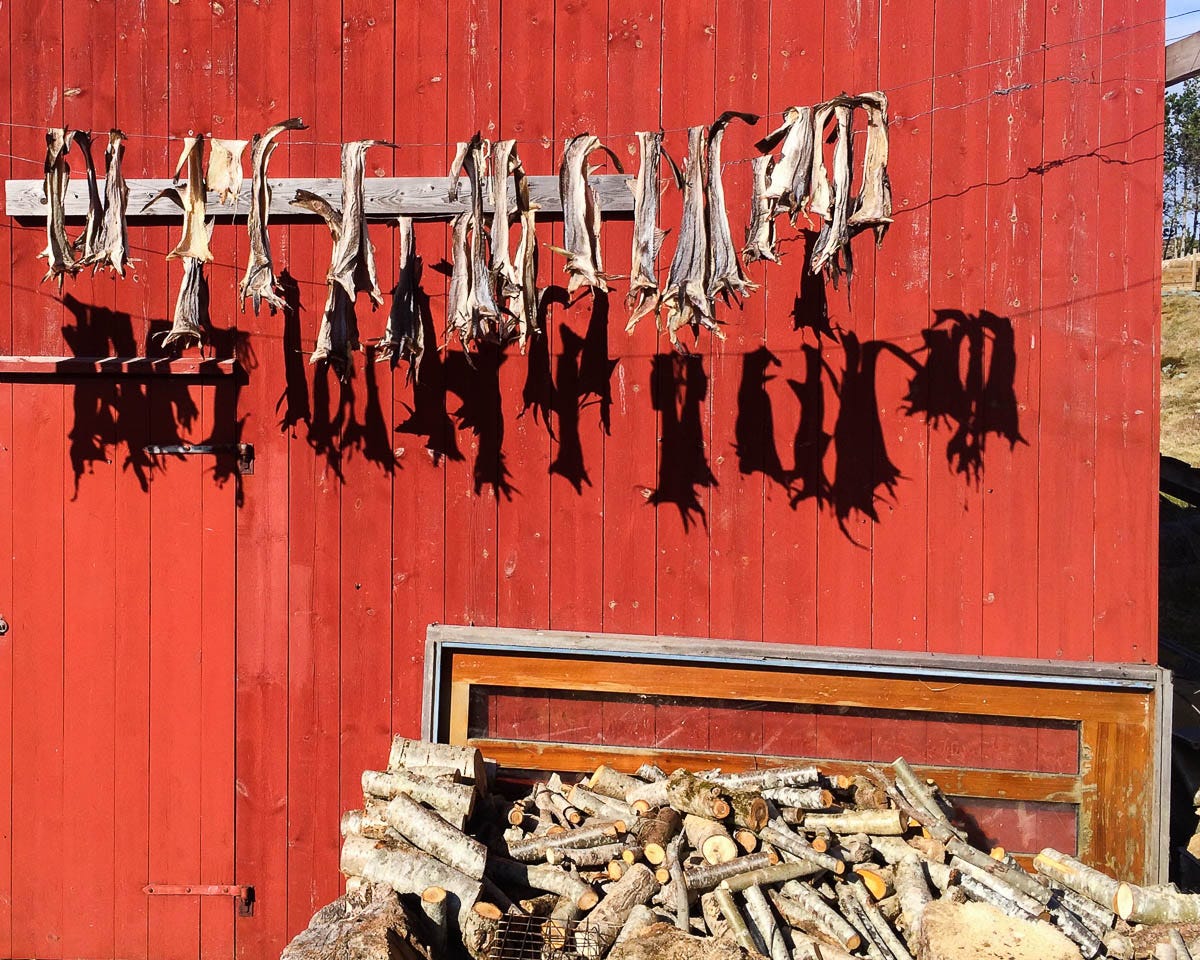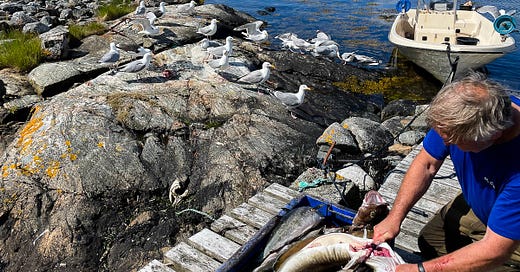From rags to riches, Norway edition
How island life was turned upside-down in the span of a single generation.
In Postcards from Istanbul, I share stories that aren’t necessarily recipe related – from Istanbul life to travels or an on-the-ground view on current events.
This week’s newsletter comes to you not from Istanbul, but from Oslo, Norway. I’ve escaped here from the Turkish summer heat, which hit a peak yesterday. While this year’s July weather have left locals in despair, I’m quite happy to trade inhumane heat for 16°C (60°F) with scattered clouds and occasional bursts of rain.
As I look out onto the wonderfully green surroundings from my parents’ flat, I thought this would be a good opportunity to leave the Middle East behind for a week and instead turn your eyes to my homeland. Because while I’ve been in Istanbul for nearly a decade, and had a connection to Turkey for longer still, Norway is where I grew up. It’s where my family lives, and where I’ll always have a home, even when I’m elsewhere.
And, most importantly for our purposes, it’s got some incredible stories to tell.
The island of Hitra
Barren, weather-beaten and stunningly beautiful, Hitra is an island off the coast of central Norway. It’s where my mother grew up and, as far back as we can trace, the generations before her. It’s the summer paradise of my childhood. Though I’ve never lived there, it’s where I go when I go “home” to Norway. I come at least once a year to spend time with family at the summer house, built right next to my mother’s childhood home.
With time, I’ve come to understand just how much life here has changed since my grandmother was born at the neighbouring farm 86 years ago. Within the lifespan of a single generation, centuries of life and customs have been turned upside down. In some ways, its story traces that of Norway’s rags-to-riches rise, but with its own unique twist.
Hitra is a sizeable island, but not an easy one. It’s essentially a large swamp with a few rocks on it, with scattered populations along the coastline. It’s flat, so there are few places to hide from the wind. What it does have though, is access to excellent fishing spots. For centuries, people here were fishermen. Once commercial whaling and the shipping industry caught on, many joined whale hunting boats or enlisted on ships that travelled the world. Some wouldn’t return for years.

Barely protected from the open Norwegian Sea by an archipelago, the weather’s rough. Hurricanes and storms are common. The weather often changes quickly, too. An example: A few years ago, my uncle took me, my partner and his brother out fishing on what was a cold, but beautiful summer day. Just a few minutes in, he told us to gather our fishing equipment. We needed to head back. There were some objections from the Turks – we could barely sense any waves or wind yet. But by the time we hit the archipelago a mere twenty minutes later, rain was gushing in our faces and the waves were becoming uncomfortably large.
My mother often retells the story of the sanctity of the radio weather forecast when she grew up. Even small children knew to keep quiet. But people also knew to add their own knowledge to the forecast. To this day, my grandmother can have a single glance out of the small kitchen window, the only in the house with a sea view, and accurately predict the sea weather for the day.
And yes, she’d warned us to be careful on that day, and return immediately at any sign of weather change.


While the men were at sea from early morning until late evening, and sometimes for months at a time, women raised children and looked after the home. There wasn’t much money, but they didn’t really need it anyway. Most kept a cow for milk, hens for eggs and a pig for Christmas. They ate self-caught fish six times a week and grew potatoes and carrots. The economy was mostly barter. My grandmother made butter, which she traded for cheese, coffee and flour well into the 1960s. Statistics would probably classify them as poor, but they were never hungry, always had family around and a community that looked after each other. Certainly not an easy way to live, but in any meaningful sense of the word, they weren’t poor either.
This manifests itself very clearly in the family tree. Many lived well into their 80s, 90s even, even several generations back. But there are also many young widows. Some men died at sea, others didn’t make it through the long journey to hospital after sudden (otherwise treatable) illnesses. Even today, the nearest hospital is several hours away.
An unimaginable transformation
Life at the island today is barely recognisable.
Though his skills were transferred to my uncle from a young age, my grandfather was the last fisherman of our family. He wasn’t the only one to leave his fishing equipment behind in the boat house. The small, self-employment fishing boats have all but disappeared. Villages went into decline and started aging, with youngsters like my mother seeking a different life elsewhere.
Until new adventures came along.
If you’ve eaten Norwegian salmon, there’s a good chance it came from this region. The neighbouring island of Frøya, only accessible by first going through Hitra, is home to a multitude of salmon farm companies. It’s also home to the richest Norwegian, all courtesy of the salmon farming industry (something that raises questions of exploitation of both natural resources and workers, but that’s a topic for another day).

Hitra also has its fair share of salmon farms, but has made an even bigger name in gourmet seafood. Visit one of the many upscale Michelin accoladed restaurants in Oslo and chances are you’ll find the menu boasts of scallops or crabs from Hitra.
Once isolated, the island is now brimming with people from various nationalities who’ve come here for work, which can be tough and seasonal, but is well paid. Both Hitra and Frøya are bucking the trend of small municipalities in the age of globalisation, growing both their population numbers and economies.
Even the few local fishermen who’ve stuck with one-man fishing boats earn a good living from the high quality and plentiful catch the local seas have to offer.
We got a glimpse of this just last week, on another fishing trip with my uncle. Using very basic equipment, we quickly filled our 70 kg (155 lbs) capacity box with a range of local fish, including cod, pollock and rose fish.
The key is knowing where to go. Knowledge that’s been handed down by my grandfather a long, long time ago and is now safely stored in the hobby boat’s mobile GPS unit.
🔜 Coming Friday for paid subscribers: Norwegian oat cookies
One of my most popular recipes with Norwegian readers, and for good reason. These cookies are wholesome and not too sweet, but still feel like a treat. With a little trick involving flat bottomed cups and baking parchment, they’re also a breeze to make – I’ve made them in 30 minutes when I’ve had visitors show up at short notice (it’ll probably take a little longer the first few times).
I’ll share the recipe with paying subscribers on Friday. Paid subscriptions are what enable this newsletter to keep coming. To support the newsletter and get exclusive weekly recipes, please consider becoming a paying subscriber.
Now is the last chance to make use of the introductory offer – annual subscriptions are 20% off through the end of month.
The next free newsletter will hit your inbox in a week, with a topic that returns to Turkey and the Middle East.
With very best wishes from Norway,
Vidar
PS! Got curious about Norwegian food culture?
Here are a couple of good places to start exploring Norwegian food culture:
Andreas Viestad is by some margin Norway’s foremost food writer, and he’s done plenty of work in English as well. His book Kitchen of Light: New Scandinavian Cooking remains in print nearly two decades after publishing, a huge testament to its timeless quality. Andreas played no small part in my own adventures as a food writer, dedicating one of his newspaper columns to my work just a few months after I started my Norwegian blog. He inspired me to turn my hobby into a career and I’m fortunate to now consider him a friend.
Nevada Berg was born in Utah, married a Norwegian and eventually settled at a farm in countryside Norway about the same time I moved to Istanbul. She’s published two books of Norwegian-inspired cooking and also keeps a brilliant blog at North Wild Kitchen, which won Blog of the Year at the Saveur Magazine Food Blog Awards.











My great grandfather and grandmother were Swedish, and settled in South Portland, Maine. My great grandmother, I’m told, was born on an island off of Norway, “ but there’s no Finnish blood in our family “…? I’ve always taken issue with this, they had boats, they swam. Thank you for this writing!